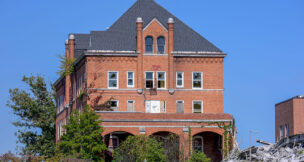Small yet mighty
Way back when, Roanoke was a train city — the headquarters for Norfolk and Western Railway and a late-1800s hub for the Shenandoah Valley Railroad. The scenic mountain community, however, has grown into a bustling region with a variety of successful industries, including one standout: health care. With the formation of Virginia Tech Carilion School […]
Va. Tech names SVP for advancement
Virginia Tech has promoted Charlie Phlegar to senior vice president for advancement, the university announced Thursday. Phlegar has led efforts in fundraising, alumni relations, communications and marketing since 2015. Under his leadership, Tech’s advancement division has secured record amounts of new gifts and commitments, including $268.5 million in fiscal year 2021-2022. Undergraduate giv[...]
VCU to open $125M STEM building next week
Virginia Commonwealth University will open its $125 million College of Humanities and Sciences’ 168,000-square-foot STEM building during a ribbon cutting scheduled next week. The six-floor building, located at 817 W. Franklin St. in Richmond, will expand lab, classroom and office space for the college, which is home to 17 departments, two schools and three programs. […]
Hampton Roads consortium opens research HQ
The Hampton Roads Biomedical Research Consortium opened its headquarters at Old Dominion University‘s Tri-Cities Center in Suffolk Friday. The consortium is a partnership between ODU, Norfolk State University, Eastern Virginia Medical School and Sentara Healthcare Inc., and was founded in June 2020. Its goal is to address health care disparities, jumpstart scientific research and advance [&h[...]
Goodwill Industries of the Valleys names chief people officer
Roanoke-based Goodwill Industries of the Valleys has named Rachel Putman as its chief people officer. In her new role, which was effective Feb. 20, Putman will lead mission services and organizational development, which includes human resources, employee engagement and learning and development. Putman comes to Roanoke from Goodwill Industries of Upstate/Midlands South Carolina, where she […[...]
UMW alumna gives $30M to support research, scholarships
A 1959 graduate of the University of Mary Washington has bequeathed $30 million to her alma mater — the largest donation in the Fredericksburg university’s 115-year history — to support undergraduate research and scholarships, UMW announced Thursday. Irene Piscopo Rodgers, who died in 2022, earned a bachelor’s degree in chemistry from what was then called […]
The big freeze
Given pandemic-caused interruptions, college students have been through a lot so far this decade, but one silver lining at many Virginia schools has been frozen tuition. Virginia Gov. Glenn Youngkin made it a priority to keep costs flat this academic year, and he succeeded in getting all 15 of the state’s public colleges and universities […]
Va. Tech names new biz school dean
Saonee Sarker, a professor at Sweden’s Lund University, will serve as the next dean of the Virginia Tech’s Pamplin College of Business following an international search. Virginia Tech announced Sarker’s new role Monday. She has been a professor in Lund University’s Department of Informatics in the School of Economics and Management since 2021, and is also a […]
Angela and Carl Reddix donate $1.1M to JMU
James Madison University alumni Angela and Carl Reddix have made a $1.1 million commitment to their alma mater to support first-generation college students, JMU announced Friday. Founder, president and CEO of Norfolk-based ARDX, a health care management and IT consulting firm, Angela Reddix studied marketing at JMU and graduated in 1990. Her husband, Carl, studied […]
CNU chooses next president, Coast Guard Academy chief
U.S. Coast Guard Academy Superintendent Rear Adm. William G. Kelly will become Christopher Newport University‘s sixth president on July 1, the Newport News-based public liberal arts school announced Thursday. CNU Chief of Staff Adelia P. Thompson has been serving as interim president since former President Paul S. Trible Jr.’s retirement at the end of the […]
Head of the class
Donald Alexander Jr. considered multiple schools, as well as the Air Force, before he landed at Norfolk State University in 2019. The Chesapeake native grew up with strong ties to the university, one of Virginia’s two public historically Black colleges and universities. As an elementary schooler, Alexander went to summer camp on Norfolk State’s campus, […]
New VCCS chancellor set to start April 1
The Virginia State Board for Community Colleges on Wednesday announced that it hired David Doré to lead the state’s 23 community colleges. Doré currently serves as president of campuses and executive vice chancellor for student experience and workforce development at Tucson, Arizona-based Pima Community College, where more than 30,000 students are enrolled. He replaces Sharon […]























